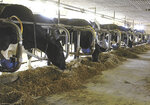

CHETEK, Wis. – Dairy farmers work step by step to make desired changes to the facilities where they build their dreams to prioritize projects that will make their dairy farms better homes for their herds.
[[In-content Ad]]
Sam and Brittany Olson of Chetek are no different. Sam returned to his family’s farm after graduating from the University of Wisconsin-River Falls in 2014 and is the fifth generation of his family to operate the Barron County farm. Brittany joined Sam following their engagement in 2015 and their marriage in 2016.
“You just decide what your weakest point is and fix that first,” Sam said. “Brittany started with the calf hutches right after we got married, and we got all our calves out of the old calf barn. That made a huge difference there, and now the top end is figured out with the milking barn done. Now, we just need to take care of everything in between.”
The Olsons milk nearly 50 Holsteins and Jerseys and utilize rotational grazing throughout the warmer months of the year. After taking over the day-to-day management of the herd, the Olsons went through a period of aggressive culling to begin clearing the way for placing their stamp on the face of the herd.
“We developed a lower tolerance for mean cows and families that had high (somatic) cell counts,” Sam said. “We just got rid of a lot of problems.”
Breeding cows that are profitable and work well under their management style is a priority for the Olsons, and they pay close attention to selecting for strength and body capacity priority traits in their mating decisions.
Sam had been exploring ideas for upgrading the stalls in the barn to fit the kind of cows he wants to breed.
“We kicked around the idea of a new tiestall barn and then a freestall barn, milking in here until we could build a parlor, and that was all cost prohibitive too,” Sam said. “Then milk prices nose dived, and it was a waiting game. I bet I had at least one new drawing made up just about every month of what we could do, should do, might do.”
When the time came to actually pursue the project, the Olsons went with the plan that was the most economically feasible.
The original portion of the barn was built in 1902 just before Sam’s great-great-grandfather purchased the farm after moving to Barron County from Decorah, Iowa.
“When he bought this farm, the barn was virtually new, and it was one of the first barns of this style in the territory,” Sam said. “With the exception of about a week and a half when the stalls in this part were being redone, cows have been milked in this barn every day for 120 years.”
Sam’s grandfather made an addition to the barn in 1957 to increase the family’s dairy herd to about 50 cows.
The two rows of tie stalls face head to head. The old section of the barn contained small stalls, many of which were stanchions the Olsons used for heifers. Brittany’s small herd of Jerseys occupied the remaining smallest stalls. Before the renovation, the stalls were 42 to 48 inches wide and 60 inches long.
The Olsons kept some of the stalls in the old section of the barn the same size for their Jersey cows. But, those stalls went from being some of the largest in the barn to being the smallest.
Now, the barn boasts 14 stalls that are 54 inches wide and 72 inches long for mature Holstein cows; 26 48-inch by 68-inch stalls for smaller Holsteins and 10 stalls for Jerseys that measure 48 inches wide by 60 inches long. The Olsons kept the number of stalls at 50.
“Our 2-year-old Holsteins are bigger now than our mature cows had been for years,” Sam said. “We wanted to move toward bigger framed Holsteins, so we needed to make the stalls to match.”
Getting underway in October 2021, the entire project took about two weeks and was not without its hiccups. In the original part of the barn, the contractors found three different floors, making the work of preparing for new concrete more time consuming.
All of the concrete between the gutters was taken out, and the sunken mangers were replaced with flat, tiled mangers to make cleaning easier. The changes also allow for more room for feed in front of each cow.
The Olsons sourced used tie stalls for a reasonable investment that suited their needs. They also purchased used mats that had a great deal of life remaining for half the barn. New mats were put in the other half of the barn to spread future replacement costs out.
Six months after completing the project, the Olsons are pleased with the fruits of their labor, and Brittany said cow comfort has improved.
“Bulk tank wise, we are up about 15 pounds per cow, and the cows are showing better heats,” Brittany said. “It is so nice to come into the barn and see everyone laying down, comfortable and relaxed. They are maintaining their body condition better, post-calving. That tells me they are making more milk and less stressed out doing it.”
Sam agreed.
“The cows have more room, and we have more room to milk them,” he said. “Some of them you could hardly squeeze into the stall with the cows. We wanted to do it once, and do it right. It just allows us to do a better job for the cows.”
Comments
No comments on this item Please log in to comment by clicking here